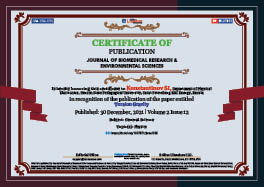Konstantinov SI*
Volume2-Issue12
Dates: Received: 2021-12-18 | Accepted: 2021-12-28 | Published: 2021-12-30
Pages: 1309-1314
Abstract
Based on the discovery by astrophysicists of dark matter halos around galaxies, stars and planets, it became possible to abandon the speculative concept of the spatial curvature of Einstein's space-time fabric and geometric gravity. Torsional gravity and spinors in fundamental theoretical physics should be based on a new cosmology, including a dark matter halo rotating with planets, stars and galaxies and forming funnels in the continuous space environment of a quantum vacuum (dark matter). The article discusses the nature of tornado and tropical hurricanes.
FullText HTML
FullText PDF
DOI: 10.37871/jbres1388
Certificate of Publication

Copyright
© 2021 Konstantinov SI. Distributed under Creative Commons CC-BY 4.0
How to cite this article
Konstantinov SI. Torsion Gravity. J Biomed Res Environ Sci. 2021 Dec 30; 2(12): 1309-1314. doi: 10.37871/jbres1388, Article ID: JBRES1388, Available at: https://www.jelsciences.com/articles/jbres1388.pdf
Subject area(s)
University/Institute
References
- Farnes JS. A unifying theory of dark energy and dark matter: Negative masses and matter creation within a modified ΛCDM framework. Astronomy & Astrophysics. 2018. doi: 10.1051/0004-6361/201832898
- Konstantinov SI. Halo of dark matter and gravitational waves. Global Journals Inc. 2020;20(4):5-11. https://tinyurl.com/4ecswzwc
- Krishnan VV, Bailes M, Van Straten W, Wex N, Freiree, PCC, Keane EF, Tauris TM, Rosado PA, Bhat NDR, Flynin C, Jameson A, Osłowski S. Lense-Thirring frame dragging induced by a fast-rotating white dwarf in a binary pulsar system. Science. 2020;367(6477):577-580. doi: 10.1126/science.aax7007
- Dominique Eckert. Where are the baryons?. University of Geneva. 2015. https://tinyurl.com/2p8n5jru
- Konstantinov SI. The awake project at CERN and the T-15 MD tokamak in Sarovo (Russia) in the light of Maxwell’s Real Electrodynamics. International Journal of Advanced Research in Physical Science (IJARPS). 2021;8(2):13-21. https://tinyurl.com/2u6sdc96
- Konstantinov SI. Review of some projects connected with of fundamental laws of physics. Journal of Computer and Electronic Sciences (JCES). 2015;1(2):32-41.
- Konstantinov SI. Epistemological Dualism between Einstein's relativity and quantum mechanics in the five-dimensional continuum for Universe. Global Journals Inc. 2020;20(6):31-38. https://tinyurl.com/2p8tvvfn
- Levantovsky VI. The mechanics of space flight in an elementary presentation. Science. 1980.
- Fabbri L. The fundamental theory of torsional gravity. 2021; 7(305). doi: 10.3390/universe7080305
- Autti S, Ahlstrom SL, Haley RP, Jennings A, Pickett GR, Poole M, Schanen R, Soldatov AA, Tsepelin V, Vonka J, Wilcox T, Woods AJ, Zmeev DE. Fundamental dissipation due to bound fermions in the zero-temperature limit. Nature Communications. 2020. doi: 10.1038/s41467-020-18499-1
- Einstein A. Collected scientific works. Moscow: Nauka. 1967. p.200-227.
- Shipov GI. The theory of physical vacuum. Theory, experiments and technologies. Moscow: Science. 1997.
- Cartan E. Compt Rend. 1922;174:437.
- Kozyrev NA. Selected works. Publishing house Leningrad. University. 1991.
- Dyatlov VL. Polarization model of an inhomogeneous physical vacuum. Novosibirsk, Institute of Mathematics. 1998.
- Chianchi R, Fabbri L, Vignolo S. Critical exact solutions for self-gravitating Dirac fields. Euro Phys JC. 2016;76:595. doi: 10.1140/epjc/s10052-016-4428-7
- Groshev VL. From gravity-through hadron, the Tunguska phenomenon, Chernobyl and Sasovo-up to lithospheric disasters. St. Petersburg: MSA. 2002.
- Litasov KD, Shatskiy AF. Composition and constitution of the Earth’s core. Novosibirsk Publishing House of the Siberian Branch of the RAS. 2016.
- Tamm IE. Fundamentals of the theory of electricity. 1954.
- Merkulov VI. Electrogravidynamic model of UFOs, tornadoes, tropical hurricanes. Novosibirsk, Institute of Mathematics. 1998.